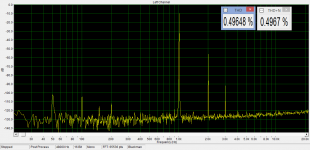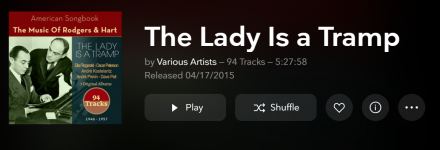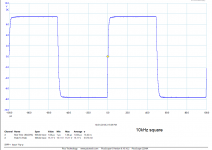Another of my series of listening tests. This time, we have 2 files, and it is a comparison of a "wire sound" and a "tube sound". One of the files is recorded just through the link cable and the second one is recorded through the tube preamp with distortion spectrum shown in the attachment. The distortion is almost independent on frequency, but depends on level.
The test files are at
http://pmacura.cz/ella.zip
Please vote in the poll which of the files sound you prefer and please also leave some comment here.
It would be nice if you could post a foobar ABX protocol or screenshot to verify you were able to verify the sound difference.
Thank you and have fun!
--------------------------------------
The poll expires today, so here is a bonus, same test setup and same music but another take, now in 24-bit resolution saved as 32-bit PCM floating point wav
http://pmacura.cz/trees.zip
Please do not mix these new files in a test with original ones, they have different volume level.
---------------------------------------------
Nov 15, 8:05 pm
The poll has just expired. As you could read in another thread, the files were:
- ella1 recorded through a tube preamplifier
- ella2 recorded through a link cable
The soundcard was playing a mono file. Left channel of the DAC was connected to the tube preamp input, tube preamp output was connected to left channel ADC input. Right channel of the DAC was connected directly to the right channel ADC input.
A stereo file was recorded, simultaneously tube channel and wire channel. A stereo file was then split into two mono files. Levels were equalized within 0.1dB order. Two mono files were posted as test files.
===================================
November 16
I was asked, by my colleagues at our local forum, to prepare a new test with more contemporary recording that would in 24-bit resolution. So I took their recommendation and prepared the same test chain with new files, that may be downloaded from
Dropbox - skot.zip
This time, I am not indicating which file is which, it is up to you, dear listeners. And tell me which one you prefer and please attach an ABX protocol, in case you have any.
The test files are at
http://pmacura.cz/ella.zip
Please vote in the poll which of the files sound you prefer and please also leave some comment here.
It would be nice if you could post a foobar ABX protocol or screenshot to verify you were able to verify the sound difference.
Thank you and have fun!
--------------------------------------
The poll expires today, so here is a bonus, same test setup and same music but another take, now in 24-bit resolution saved as 32-bit PCM floating point wav
http://pmacura.cz/trees.zip
Please do not mix these new files in a test with original ones, they have different volume level.
---------------------------------------------
Nov 15, 8:05 pm
The poll has just expired. As you could read in another thread, the files were:
- ella1 recorded through a tube preamplifier
- ella2 recorded through a link cable
The soundcard was playing a mono file. Left channel of the DAC was connected to the tube preamp input, tube preamp output was connected to left channel ADC input. Right channel of the DAC was connected directly to the right channel ADC input.
A stereo file was recorded, simultaneously tube channel and wire channel. A stereo file was then split into two mono files. Levels were equalized within 0.1dB order. Two mono files were posted as test files.
===================================
November 16
I was asked, by my colleagues at our local forum, to prepare a new test with more contemporary recording that would in 24-bit resolution. So I took their recommendation and prepared the same test chain with new files, that may be downloaded from
Dropbox - skot.zip
This time, I am not indicating which file is which, it is up to you, dear listeners. And tell me which one you prefer and please attach an ABX protocol, in case you have any.
Attachments
Last edited:
Hi PMA,
I don't know whether this is a useful result? I could not tell the difference between the wav files using foobar ABX and I do not have a preference. But I did compare them with what I think is the same recording on TIDAL and the latter is easy to identify and sounds better to me. By better I mean less brittle, more natural voice, more space between instruments. On the other hand, I didn't ABX with TIDAL so I may be delusional. Or the recording may be different. Or the software processing between foobar and TIDAL may be different.
I am curious how you are digitizing the tracks...how good is your recording process?
Also, I imagine the track was originally recording using valves; would this affect the comparison?
I don't know whether this is a useful result? I could not tell the difference between the wav files using foobar ABX and I do not have a preference. But I did compare them with what I think is the same recording on TIDAL and the latter is easy to identify and sounds better to me. By better I mean less brittle, more natural voice, more space between instruments. On the other hand, I didn't ABX with TIDAL so I may be delusional. Or the recording may be different. Or the software processing between foobar and TIDAL may be different.
I am curious how you are digitizing the tracks...how good is your recording process?
Also, I imagine the track was originally recording using valves; would this affect the comparison?
Attachments
.5% 2n harmonics can be hard to detect especially if the original sound has lot of 2n content already, might be impossible.
However I am starting to have a totally different interpretation.
I can clearly hear differences when AB components between 0 feedback, moderate and high feedback, I can hear differences in 5 ,10, 50 and 100 watt tube amps.
However this whole power rating is not the explanation I think.
I put the scope yesterday on very low sensitivity speakers and they played quite loud with a vinyl. 6 ohm impedance at worst with at maximum Peak to peak 6 Volt is maybe 1 watt at a given time.
I know that waves are summed at different frequencies.
SO the next test is to place a resistor in water bucket with isolation at a temperature and measure T elevation vs time to calculate the real power dissipated by the amplifier into a load.
I will use a 8 ohm load
However I am starting to have a totally different interpretation.
I can clearly hear differences when AB components between 0 feedback, moderate and high feedback, I can hear differences in 5 ,10, 50 and 100 watt tube amps.
However this whole power rating is not the explanation I think.
I put the scope yesterday on very low sensitivity speakers and they played quite loud with a vinyl. 6 ohm impedance at worst with at maximum Peak to peak 6 Volt is maybe 1 watt at a given time.
I know that waves are summed at different frequencies.
SO the next test is to place a resistor in water bucket with isolation at a temperature and measure T elevation vs time to calculate the real power dissipated by the amplifier into a load.
I will use a 8 ohm load
SO the next test is to place a resistor in water bucket with isolation at a temperature and measure T elevation vs time to calculate the real power dissipated by the amplifier into a load.
I will use a 8 ohm load
This experiment has many error sources, calorimetry is very difficult to do accurately. If you have a purely resistive load computed true rms voltage would be easier.
Hi Scott  I did the experiment and blast the power into a 6ohm into a bucket of 1kg of water, after 4 minutes not even 1 Celcius of change which confirm the low power of audio.
I did the experiment and blast the power into a 6ohm into a bucket of 1kg of water, after 4 minutes not even 1 Celcius of change which confirm the low power of audio.
I think the rise and fall time and how the amplifier can control that is the main factor. This could explain the 'distortion' we hear in lower power amps.
At the same time low level signal loss would explain why also simpler amps with less feedback as well as low loss output transformers are praised.
I would never do a 50watt single wave test such as I do for THD purpose with a speaker connected by fear of damaging the drivers.
I think the rise and fall time and how the amplifier can control that is the main factor. This could explain the 'distortion' we hear in lower power amps.
At the same time low level signal loss would explain why also simpler amps with less feedback as well as low loss output transformers are praised.
I would never do a 50watt single wave test such as I do for THD purpose with a speaker connected by fear of damaging the drivers.
Given that varying feedback varies frequency response and our ears are quite sensitive to frequency response variations it is hardly surprising that you can hear differences as feedback is varied. To hear the difference between amplifier A with feedback and amplifier B without feedback is similarly unsurprising. I am not clear exactly what you are saying.gabdx said:I can clearly hear differences when AB components between 0 feedback, moderate and high feedback, I can hear differences in 5 ,10, 50 and 100 watt tube amps.
The next test of what? What was the first test?SO the next test is to place a resistor in water bucket with isolation at a temperature and measure T elevation vs time to calculate the real power dissipated by the amplifier into a load.
??I think the rise and fall time and how the amplifier can control that is the main factor. This could explain the 'distortion' we hear in lower power amps.
Low feedback amps are praised because some people like a little distortion and lumpy frequency response. Put those things right with well-designed feedback and those people complain of 'clinical boring' sound i.e. sound which faithfully reproduces the input signal.At the same time low level signal loss would explain why also simpler amps with less feedback as well as low loss output transformers are praised.
PS what has this to do with this thread?
This has to do that adding 2nd harmonics to a song doesn't represent tube sound.
I also think that you need a sound sample which has low 2nd harmonics in the first place and an audio system which has less 2nd harmonics than is added to one sample.
-------------------
Low feedback amps are praised because some people like a little distortion and lumpy frequency response. Put those things right with well-designed feedback and those people complain of 'clinical boring' sound i.e. sound which faithfully reproduces the input signal.
I don't think this argument holds anymore, the average listening level is at 0.5 Watt at maximum, at which any decent output transformer will have a broad frequency response and low THD. At 0.5 Watt maximum there should be no differences between a 300B (8 watts) and a 100Watt solid state.
To me it is the rise and fall time which you hear, what they call slew rate or something.
I also think that you need a sound sample which has low 2nd harmonics in the first place and an audio system which has less 2nd harmonics than is added to one sample.
-------------------
Low feedback amps are praised because some people like a little distortion and lumpy frequency response. Put those things right with well-designed feedback and those people complain of 'clinical boring' sound i.e. sound which faithfully reproduces the input signal.
I don't think this argument holds anymore, the average listening level is at 0.5 Watt at maximum, at which any decent output transformer will have a broad frequency response and low THD. At 0.5 Watt maximum there should be no differences between a 300B (8 watts) and a 100Watt solid state.
To me it is the rise and fall time which you hear, what they call slew rate or something.
Last edited:
To me it is the rise and fall time which you hear, what they call slew rate or something.
But now you describe small signal conditions where rise time is solely determined by bandwidth.
I know it makes no sense 
In the condition that both amplifiers have the same bandwidth at the relevant listening power, how could the determined maximum power bandwidth affect the perceived resolution and tone, everything being almost equal?
We already know that amplifiers which are un-able to play square waves can excel with music and vice-versa.
I think the answer will be with analyzing arbitrary wave forms with speakers connected to the output, but this test will be arbitrary...
In the condition that both amplifiers have the same bandwidth at the relevant listening power, how could the determined maximum power bandwidth affect the perceived resolution and tone, everything being almost equal?
We already know that amplifiers which are un-able to play square waves can excel with music and vice-versa.
I think the answer will be with analyzing arbitrary wave forms with speakers connected to the output, but this test will be arbitrary...
Nothing can "play" a perfect square wave as this would take infinite BW. What's your point?
You are correct, of course. However, speaking about step/square response, this tube circuit is doing it pretty well
Attachments
I also have a "null" ABX result. And the mathematical difference between the files is so tiny that it lies completely below ear masking curves.
Thank you Pavel.
If it’s not much work, can you please post the FR of the buffer stating the load at the output please?
George
Thank you Pavel.
If it’s not much work, can you please post the FR of the buffer stating the load at the output please?
George
Hi George,
not sure what you mean. The tube stage has BW(-3dB) > 300kHz.
Pavel,
You shouldn't have told us which file is which. I have a slight feeling that I like the second one better, in sense that her voice sounds just a bit more mellower and natural, but I am still not sure
You should put another recording (another song) with names X and Y, but we will not know which one went through the buffer. Or, put 3 copies, out of which only one went trough the tube. Then see if we can distinguish which one it is, and why
You shouldn't have told us which file is which. I have a slight feeling that I like the second one better, in sense that her voice sounds just a bit more mellower and natural, but I am still not sure
You should put another recording (another song) with names X and Y, but we will not know which one went through the buffer. Or, put 3 copies, out of which only one went trough the tube. Then see if we can distinguish which one it is, and why
You mean the BT thread? There was almost no response here before, and the guy seemed to be sure, so I did not resist the temptation 
I still think that the DBT is necessary to prove that one can hear the difference, regardless we know which file is which. This knowledge is erased during the DBT and the ABX test validity is not corrupted. And we do not have a single protocol yet.
Of course, I may prepare 3 files as you suggest, later.
However, we had a test in the past, with 5 files where 2 of them were identical, and people were happily commenting on differences. More anecdotally, there is a guy in the thread mentioned above who believes that he hears a difference between 2 identical files placed at different memory locations. You know, there is no boundary, people will tell you they hear a difference between 2 resistors with -140dB distortion level. My goal is to put some of them back to the ground, though I know very well this would not help much and that the belief in any kind of nonsense will go on. And the high-end audio needs it for its existence.
I still think that the DBT is necessary to prove that one can hear the difference, regardless we know which file is which. This knowledge is erased during the DBT and the ABX test validity is not corrupted. And we do not have a single protocol yet.
Of course, I may prepare 3 files as you suggest, later.
However, we had a test in the past, with 5 files where 2 of them were identical, and people were happily commenting on differences. More anecdotally, there is a guy in the thread mentioned above who believes that he hears a difference between 2 identical files placed at different memory locations. You know, there is no boundary, people will tell you they hear a difference between 2 resistors with -140dB distortion level. My goal is to put some of them back to the ground, though I know very well this would not help much and that the belief in any kind of nonsense will go on. And the high-end audio needs it for its existence.
- Status
- This old topic is closed. If you want to reopen this topic, contact a moderator using the "Report Post" button.
- Home
- General Interest
- Everything Else
- Do you like tube distortion? - listening test


